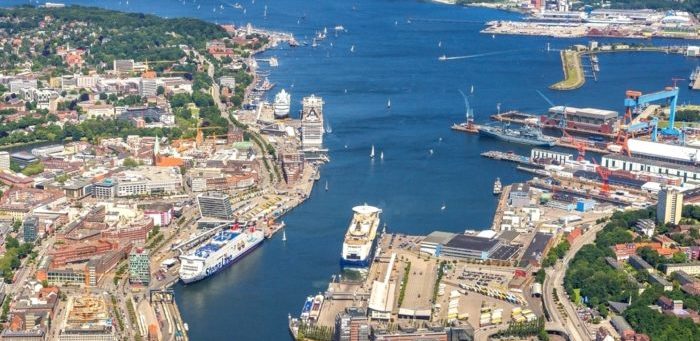German Port of Kiel and the federal state capital Kiel have cooperated on a concept aimed at providing sustainable and environmentally-oriented development in the port. ‘Blue Port Kiel’ outlines strategies and initiatives in three spheres of activity aimed at making energy resources more efficient, reducing emissions and transferring hinterland transport to rail.
The concept will be discussed over the coming weeks by the city’s leading bodies and put to Kiel’s governing Council for a resolution on 17 May. Dr Ulf Kämpfer, Lord Mayor of the Schleswig-Holstein state capital Kiel, said:
In implementing this concept, the port is making a valuable contribution towards environmental and climate protection in the state capital of Kiel. Economic strength and sustainability will go hand in hand.
Energy efficiency and environment management
The seaport of Kiel has already been covering all of its energy needs from ecologically sustainable and regenerative power sources: In the Ostuferhafen, solar panels mounted on warehouses and on passenger handling buildings utilise the power of the sun. Of the cars in the port’s vehicle fleet, 15 % are all-electric, and in the port’s forest products terminal, electrically-driven fork-lifts are in operation all the time.
Dr Dirk Claus, Managing Director of the port, said:
With the implementation of certified environment management we now want to more clearly define the way ahead while continuing to improve ourselves.

Reduction of waste emissions
This year, the port is building its first shore-based power plant aiming to further reduce emissions during the time ships are tied up. This pilot plant is being erected at the Norwegenkai Terminal and will be able to supply ships operating on the Kiel-Oslo route. In addition, studies are being undertaken to investigate whether further shore-based power plants could be technically feasible at other terminals. Dirk Claus said:
To improve economic viability and promote the spread of land-based power for ships, funding of the required technical facilities as well as exemption from levies due under Germany’s Renewable Energy Sources Act (EEG) is necessary.
Parallel to this Kiel is going to promote the supply of LNG to cruise ships during their stay. The first LNG supply operation is planned to take place in spring 2019, when the “AIDAprima” will be stationed in Kiel.
Strengthening of intermodal transport operations
Compared to truck transport, rail cargo transport emissions of fine particles, nitrous oxides and even greenhouse gases are significantly lower. In order to further increase the railways’ share in the modal split, more investment in infrastructures is planned. To that effect the rail marshalling yards at Kiel-Meimersdorf are being upgraded in the coming year to accept goods trains of 750 metres length (as against 550 metres currently).
In addition, a third marshalling and composition track will be laid along Kiel’s Railway Quay to increase the capacity of the intermodal facility at the Schwedenkai Terminal.
Last year, more than 7.4 million tons of cargo were handled at the port – an all-time record – and 2.1 million passengers used available terminal facilities to board or leave ships. The port’s hub business is ferry traffic to Norway and Sweden, as well as into the Baltic region and to Russia.






























































